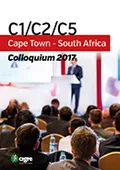Summary
CIGRE 8th Southern Africa Regional Conference
SESSION 1 - Challenges associated with the integration of Distributed Generation on Utility Networks
- 1.01 - The role and interaction of microgrids and centralized grids in developing modern power systems
- 1.02 - ‘Analysis of Utility Scale Wind and Solar Plant Performance in South Africa Relative to Daily Electricity Demand’
- 1.03 - Methodology for Assessing the Impact of Intermittent Generation on Utilities
- 1.04 - Utility Scale Battery Storage – The New Electricity Revolution
- 1.05 - Model validation for accurate representation of renewable power plant technologies in developing utilities to free up capacity
- 1.06 - Understanding the impact of embedded renewable generation and its interaction with local load in the time-domain
- 1.07 - Overcoming Hydraulic Issues Using Variable Speed Drive in a Hydro Power Scheme
SESSION 2 - Materials and Asset management developments for the future in uncertain times
- 2.01 - Field trial of carbon composite core covered conductor system
- 2.02 - Developing Reproducible Electrical Tree-Resistance Epoxy Nanodielectrics with Improved Thermal Performance
- 2.03 - Performance of Insulators under Impulse, AC and HVDC Voltage
- 2.04 - The use of 3D printing for high voltage applications and non-critical spares
- 2.05 - Pre-emptive tripping of distribution power transformers for decaying auxiliary DC supply
- 2.06 - Air Breakdown Voltage Decreases As Altitude Increases
- 2.07 - Evaluating Step and Touch Potential Risks on Earthing Systems of High Voltage Cable Systems
SESSION 3 - System Reliability and Performance improvement measures in the Wires Business
- 3.01 - Developing a model for the prediction of system reliability indices on distribution networks
- 3.02 - An integrated, coherent, big data network performance management solution
- 3.03 - Clearing of transient faults in mediumvoltage networks by means of singlephase tripping
- 3.04 - Magnetic induced currents and voltages on earthed lines due to faults on adjacent lines
- 3.05 - Advances in Power Quality Requirements for RPPs
SESSION 4 - Towards Universal Access in Africa. Creating a platform to accelerate electrification on our continent
- 4.01 - The cost of sustainable energy
- 4.02 - Servicing backyard dwellings with electricity in the City of Cape Town
- 4.03 - A Review on Policy and Cost Associated With Electrification of Informal Settlements
- 4.04 - A tool for pre-feasibility techno-economic comparison of rural electrification options: grid extension and off-grid systems
- 4.05 - Modelling an electrification connection strategy – An Eskom case study
SESSION 5 - Transmission System integration challenges
- 5.01 - Operational Studies for the Synchronization of the WAPP Interconnected Power System for the target years 2016 and 2020
- 5.02 - A Historic Perspective of Power System Disturbances in the Southern African Power Pool (SAPP)
- 5.03 - Recovery voltage analysis of the Matimba – Phokoje 400 kV transmission line during a single phase-to-earth fault
- 5.04 - Shortcomings And Proposed Improvements To The Current Practice Used By Eskom Transmission To Determine Asset Health Index Of Overhead Transmission Lines
- 5.05 - Optimise Demand Response for Primary Frequency Control
SESSION 6 - Technology solutions and innovations impacting on Transmission Design elements
- 6.01 - 765 kV Substation Acoustic Noise Impact Study by Predictive Software and Computational Approach
- 6.02 - Review, Modelling and Improvement of Transco Dispatch
- 6.03 - System inertia and Rate of Change of Frequency (RoCoF) with increasing non-synchronous renewable energy penetration
- 6.04 - Assessing the need for additional surge arresters in an uprated high voltage substation
- 6.05 - Uprating of high voltage overhead transmission lines using intermediary catenary suspenders
- 6.06 - Strategic Plan for Integrating Future Renewable Energy Generators in South Africa
SESSION 7 - Measuring Transformer health – diagnostic tools and other measures
- 7.01 - Transformers within photovoltaic generation plants: Challenges and possible solutions
- 7.02 - Holistic approach to on-line transformer monitoring: knowledge management first!
- 7.03 - Transformer oil degradation on PV plants – A Case Study
- 7.04 - Sustainable Alternate material in Power Sector (Transformer) for developing countries
- 7.05 - Advantages derived from Gas Chromatographic identification of petroleum products and additives within the power industry
- 7.06 - Employment of various strategies in Eskom to optimize the management of transformer life cycle and making the transformers part of the smart grid solution
- 7.07 - Natural Ester Oil Power Transformer Solution for PPC Slurry Substation in Eskom’s North West Operation Unit
SESSION 8 - Technology solutions and innovations impacting on Transmission Design elements
- 8.01 - Consideration to include High Surge Impedance Loading (HSIL) lines as part of system planning in Eskom
- 8.02 - Use of Thyristor Controlled Series Capacitors (TCSCs) to enhance power system transient stability and their possible application on Transmission Grids of developing economies
- 8.03 - Improved methods for surface impedance estimation in modelling of geomagnetically induced currents in power networks
- 8.04 - Dynamic Reactive Power Compensation in Modern Grids by using Variable Shunt Reactors
- 8.05 - First off achievements used on the Kappa-Sterrekus 765 kV Overhead line
- 8.06 - Seasonal Variation of Soil Resistivity and the Correction Factor
- 8.07 - Elevated lightning activity at large PV plant environments - A hypothesis and preliminary findings
SESSION 9 - Integrating Network Planning Tools with Grid Code requirements
- 9.01 - Cost of Unserved Energy in South Africa
- 9.02 - Quantitative Assessment of Geographical Based Load Forecast Technique at Eskom Distribution: Forecast Error and Impact on Infrastructure Execution
- 9.03 - Impact of SSEG on SA MV networks
- 9.04 - Innovative Method to Determine Distributed Energy Resource Hosting Capacity
- 9.05 - Non-technical loss mitigation lessons for Africa from global experiences
- 9.06 - Grid Code compliance tests of Renewable Technologies integrated on the NamPower Network
- 9.07 - Testing & Technical Evaluation for Compliance to South African Grid Code (SAGC) of the first 1800MW of
Renewable Energy
SESSION 10 - Challenges associated with the integration of Distributed Generation on Utility Networks
- 10.01 - Investigating capital deferment by installing a peak shaving and energy shifting battery storage system
- 10.02 - Initial Feasibility Studies of A Microgrid Implementation
- 10.03 - How Digital Microgrids contribute to resolving the electrification challenge
- 10.04 - Evaluation of the impact variable renewable energy sources on power system transient stability limits
- 10.05 - Costs Containment Considerations by Utilities during Implementation of IPP Projects
SESSION 11 - Planning for System Resilience in Utilities
- 11.01 - Protecting Critical Infrastructure by Adapting to Resilience Thinking for a National Blackout Risk Assessment Framework
- 11.02 - Power system resilience – enablers supporting an effective Blackout response
- 11.03 - Addressing Emergency Decision Making in Complex incidents: Implementation of Advanced Incident Command System in Eskom
- 11.04 - Network and Data Security Strategy of the Electric Power System
- 11.05 - Going Digital – Opportunities across the Utility asset life-cycle
Additional informations
| Publication type | Colloquia |
|---|---|
| Reference | COLL_CAP_2017 |
| Publication year | |
| Publisher | CIGRE National Committee |
| Study committees | |
| Price for non member | Free |
| Price for member | Free |




